The Effects of Target Thicknesses and Backing Materials on a Ti-Cu Collision Weld Interface Using Laser Impact Welding
Abstract
:1. Introduction
2. Materials and Methods
3. Results and Discussion
3.1. Measuring the Flyer Velocity
3.2. The Effect of Directionality
3.3. The Effect of Target Thickness
3.4. The Effect of Backing Material (Steel versus Acrylic Backing)
3.5. Mechanical Testing (Lap Shear Test)
4. Conclusions
- One noteworthy finding is that utilizing a single launch system, as described previously, enables the welding of efficient joints ranging from 127 µm to 1000 µm of target thickness, without the need for any alterations in the process.
- The wavelength and amplitude of the interfacial waves had greater magnitudes in the direction perpendicular to the stand-off, as compared to the parallel orientation.
- Increasing the target thickness increased the interfacial wave amplitude until approximately twice the flyer thickness was attained; beyond this threshold, a subsequent reduction in interfacial waves was observed.
- Interfacial waves formed closer to the weld center at a distance of 1.5 mm when an acrylic backing was employed, whereas this distance extended to 2 mm in the case of a steel backing.
- The unwelded zone at the center of the weld exhibited a smaller extent in instances where an acrylic backing was used, in contrast to scenarios involving a steel backing.
- Interfacial wavelength and amplitude were greater when an acrylic backing was used, as opposed to the use of a steel backing.
- During lap shear testing, in all cases, the welds did not experience failure at the interface; instead, failures occurred within the base metal. Failures occurred at the Cu side (for 127, 152, and 254 µm target thickness) leaving a complete weld nugget. For thicker target thickness (508 µm and 1 mm), failure occurred at the Ti side around the nugget which indicated that the interfacial joint had a high strength.
Author Contributions
Funding
Data Availability Statement
Acknowledgments
Conflicts of Interest
References
- Khanna, O.P. Welding Technology; Dhanpat Rai & Co.: New Delhi, India, 2010. [Google Scholar]
- Messler, R.W. Joining of Materials and Structures: From Pragmatic Process to Enabling Technology; Elsevier: Amsterdam, The Netherlands; Boston, MA, USA, 2004. [Google Scholar]
- Martinsen, K.; Hu, S.J.; Carlson, B.E. Joining of dissimilar materials. CIRP Ann. 2015, 64, 679–699. [Google Scholar] [CrossRef]
- Wang, H.; Wang, K.; Zheng, W. Microstructure complexities of laser impact welded Al-Ti bonding interface. Scr. Mater. 2022, 211, 114488. [Google Scholar] [CrossRef]
- Dimatteo, V.; Ascari, A.; Liverani, E.; Fortunato, A. Experimental investigation on the effect of spot diameter on continuous-wave laser welding of copper and aluminum thin sheets for battery manufacturing. Opt. Laser Technol. 2022, 145, 107495. [Google Scholar] [CrossRef]
- Hunt, J.N. Wave formation in explosive welding. Philos. Mag. J. Theor. Exp. Appl. Phys. 1968, 17, 669–680. [Google Scholar] [CrossRef]
- Blazynski, T.Z. (Ed.) Explosive Welding, Forming and Compaction; Springer: Dordrecht, The Netherlands, 1983. [Google Scholar] [CrossRef]
- Godunov, S.K.; Deribas, A.A.; Zabrodin, A.V.; Kozin, N.S. Hydrodynamic effects in colliding solids. J. Comput. Phys. 1970, 5, 517–539. [Google Scholar] [CrossRef]
- Cowan, G.R.; Bergmann, O.R.; Holtzman, A.H. Mechanism of bond zone wave formation in explosion-clad metals. Metall. Trans. 1971, 2, 3145–3155. [Google Scholar] [CrossRef]
- Wang, K.; Wang, H.; Zhou, H.; Zheng, W.; Xu, A. Research Status and Prospect of Laser Impact Welding. Metals 2020, 10, 1444. [Google Scholar] [CrossRef]
- Lee, T.; Zhang, S.; Vivek, A.; Kinsey, B.; Daehn, G. Flyer Thickness Effect in the Impact Welding of Aluminum to Steel. J. Manuf. Sci. Eng. 2018, 140, 121002. [Google Scholar] [CrossRef]
- Wang, X.; Wang, X.; Li, F.; Lu, J.; Liu, H. Interface Kinematics of Laser Impact Welding of Ni and SS304 Based on Jet Indentation Mechanism. Metall. Mater. Trans. A 2020, 51, 2893–2904. [Google Scholar] [CrossRef]
- Ben-Artzy, A.; Stern, A.; Frage, N.; Shribman, V.; Sadot, O. Wave formation mechanism in magnetic pulse welding. Int. J. Impact Eng. 2010, 37, 397–404. [Google Scholar] [CrossRef]
- Vivek, A.; Liu, B.C.; Hansen, S.R.; Daehn, G.S. Accessing collision welding process window for titanium/copper welds with vaporizing foil actuators and grooved targets. J. Mater. Process. Technol. 2014, 214, 1583–1589. [Google Scholar] [CrossRef]
- Sunny, S.; Gleason, G.; Mathews, R.; Malik, A. Simulation of laser impact welding for dissimilar additively manufactured foils considering influence of inhomogeneous microstructure. Mater. Des. 2021, 198, 109372. [Google Scholar] [CrossRef]
- Kapil, A.; Lee, T.; Vivek, A.; Cooper, R.; Hetrick, E.; Daehn, G. Spot impact welding of an age-hardening aluminum alloy: Process, structure and properties. J. Manuf. Process. 2019, 37, 42–52. [Google Scholar] [CrossRef]
- Thurston, B.; Lewis, T.; Li, J.; Vivek, A.; Daehn, G. Augmented Laser Impact Welding: A New Process Demonstration in Welding Aluminum Alloy 2024-T3. J. Mater. Eng. Perform. 2023. [Google Scholar] [CrossRef]
- Wang, H.; Taber, G.; Liu, D.; Hansen, S.; Chowdhury, E.; Terry, S.; Lippold, J.; Daehn, G. Laser impact welding: Design of apparatus and parametric optimization. J. Manuf. Process. 2015, 19, 118–124. [Google Scholar] [CrossRef]
- Wang, Q.; Wang, H.; Ran, M.; Tong, Z.; Wang, R.; Zheng, W. The achievement of lap weld and gap control for laser impact welding with water as the confinement layer. J. Manuf. Process. 2023, 95, 105–114. [Google Scholar] [CrossRef]
- Rija Nirina, R.; Sapanathan, T.; Buiron, N.; Rachik, M. Magnetic pulse welding of Al/Al and Al/Cu metal pairs: Consequences of the dissimilar combination on the interfacial behavior during the welding process. J. Manuf. Process. 2015, 20, 112–127. [Google Scholar] [CrossRef]
- Jaramillo, D.; Szecket, A.; Inal, O.T. On the transition from a waveless to a wavy interface in explosive welding. Mater. Sci. Eng. 1987, 91, 217–222. [Google Scholar] [CrossRef]
- Kawano, R.; Tanaka, S.; Inao, D.; Hokamoto, K. Acceleration of metal plates by hybridization of electrical and chemical energy for potential application in high-velocity impact welding. J. Mater. Process. Technol. 2023, 318, 118014. [Google Scholar] [CrossRef]
- Wang, Q.; Wang, K.; Wang, H.; Zheng, W. Variety of microstructure and mechanical properties along the laser impact welded interface. Sci. Technol. Weld. Join. 2023, 28, 128–136. [Google Scholar] [CrossRef]
- Lee, T.; Zhang, S.; Vivek, A.; Daehn, G.; Kinsey, B. Wave formation in impact welding: Study of the Cu–Ti system. CIRP Ann. 2019, 68, 261–264. [Google Scholar] [CrossRef]
- Jaramillov, D.; Inal, O.T.; Szecket, A. Effect of base plate thickness on wave size and wave morphology in explosively welded couples. J. Mater. Sci. 1987, 22, 3143–3147. [Google Scholar] [CrossRef]
- Zhang, S.; Lueg-Althoff, J.; Hahn, M.; Tekkaya, A.E.; Kinsey, B. Effect of Process Parameters on Wavy Interfacial Morphology During Magnetic Pulse Welding. J. Manuf. Sci. Eng. 2020, 143, 011010. [Google Scholar] [CrossRef]
- Gleason, G.; Sunny, S.; Mathews, R.; Malik, A. Numerical investigation of the transient interfacial material behavior during laser impact welding. Scr. Mater. 2022, 208, 114325. [Google Scholar] [CrossRef]
- Moghaddas, M.A.; Abdollah-zadeh, A.; Hajian, M. The effects of back-plate support and welded metal type on the characteristics of joints produced by magnetic pulse welding. Int. J. Adv. Manuf. Technol. 2019, 102, 379–392. [Google Scholar] [CrossRef]
- Meng, Z.; Zhou, R.; Gong, M.; Guo, W.; Liu, W.; Huang, S. Interface formation and interlayer factors of three-dissimilar-metal layers joint in impact welding. J. Manuf. Process. 2021, 70, 414–426. [Google Scholar] [CrossRef]
- Meyers, M.A. Dynamic Behavior of Materials, 1st ed.; John Wiley & Sons, Ltd.: Hoboken, NJ, USA, 1994. [Google Scholar] [CrossRef]
- Gleason, G.; Bailey, K.; Sunny, S.; Malik, A.; Bernal, R.A. Influence of surface roughness on the transient interfacial phenomena in laser impact welding. J. Manuf. Process. 2022, 80, 480–490. [Google Scholar] [CrossRef]
- Liu, H.; Jin, H.; Shao, M.; Tang, H.; Wang, X. Investigation on Interface Morphology and Mechanical Properties of Three-Layer Laser Impact Welding of Cu/Al/Cu. Metall. Mater. Trans. A 2019, 50, 1273–1282. [Google Scholar] [CrossRef]
- Gupta, M.K.; Singh, N.K.; Gupta, N.K. Energy dissipation and notch sensitivity of mild steel at different strain rates and temperatures. Int. J. Impact Eng. 2023, 178, 104610. [Google Scholar] [CrossRef]
- Liu, H.; Yang, B.; Wang, C.; Han, Y.; Liu, D. The mechanisms and applications of friction energy dissipation. Friction 2022, 11. [Google Scholar] [CrossRef]
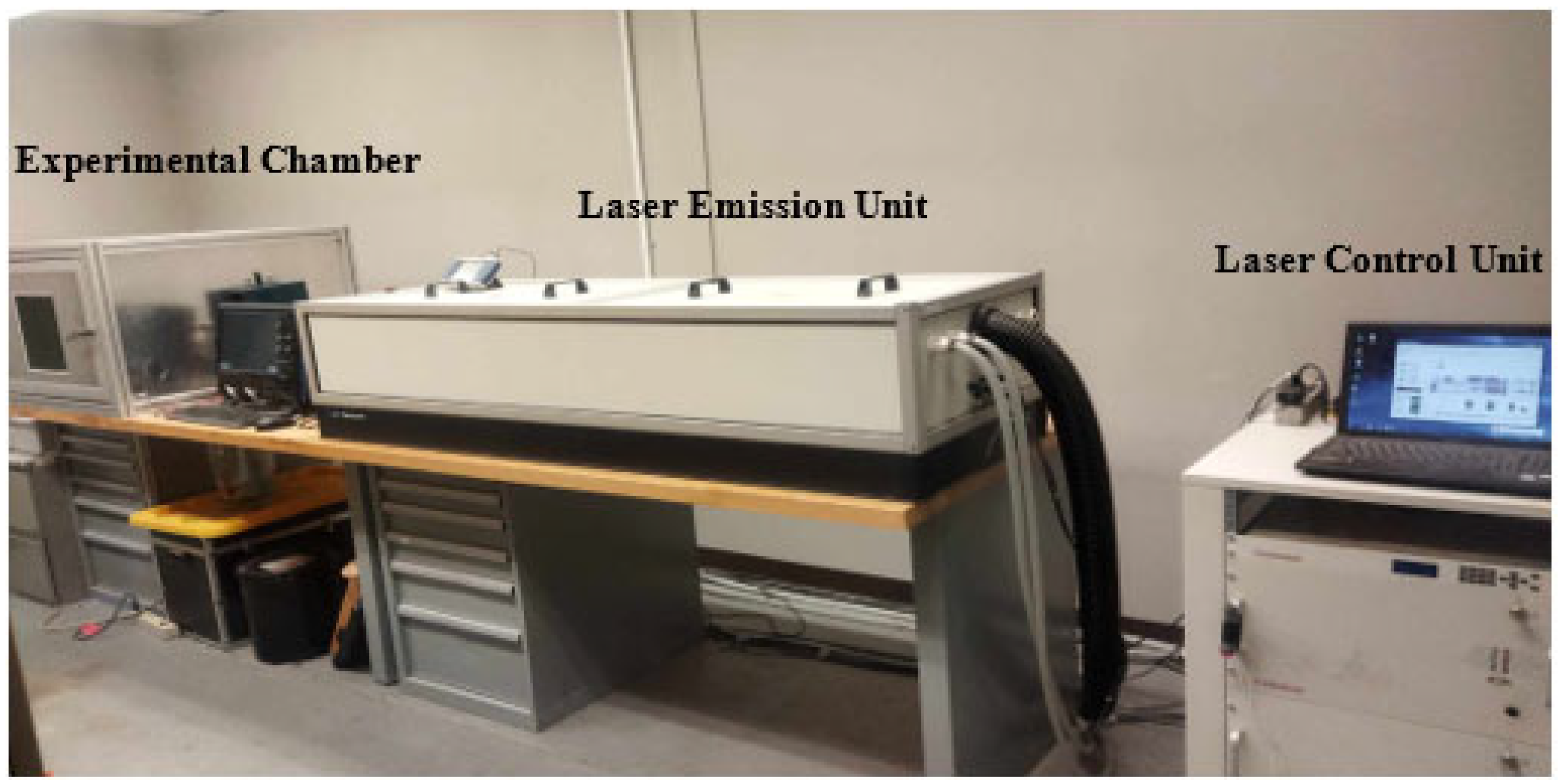
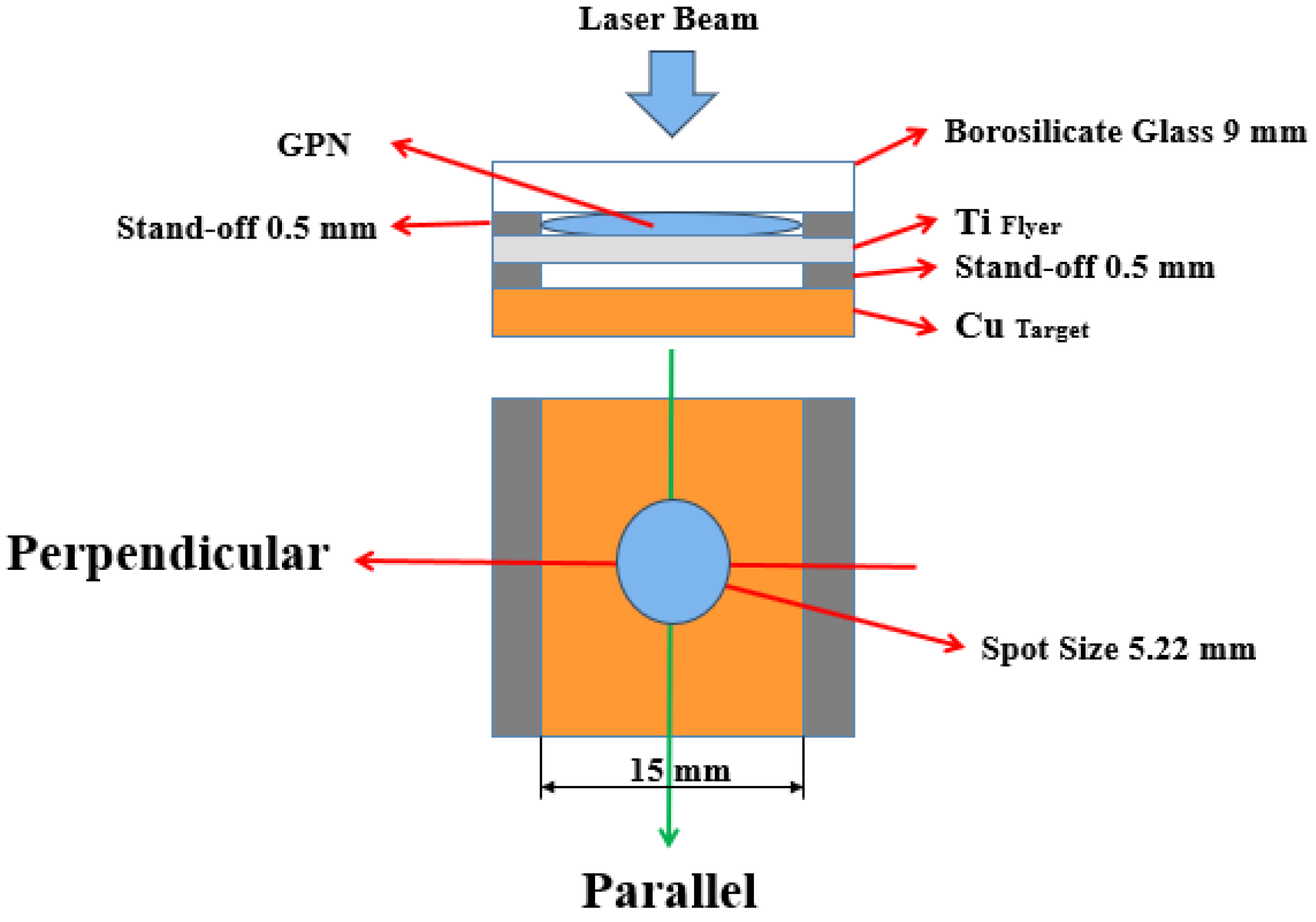
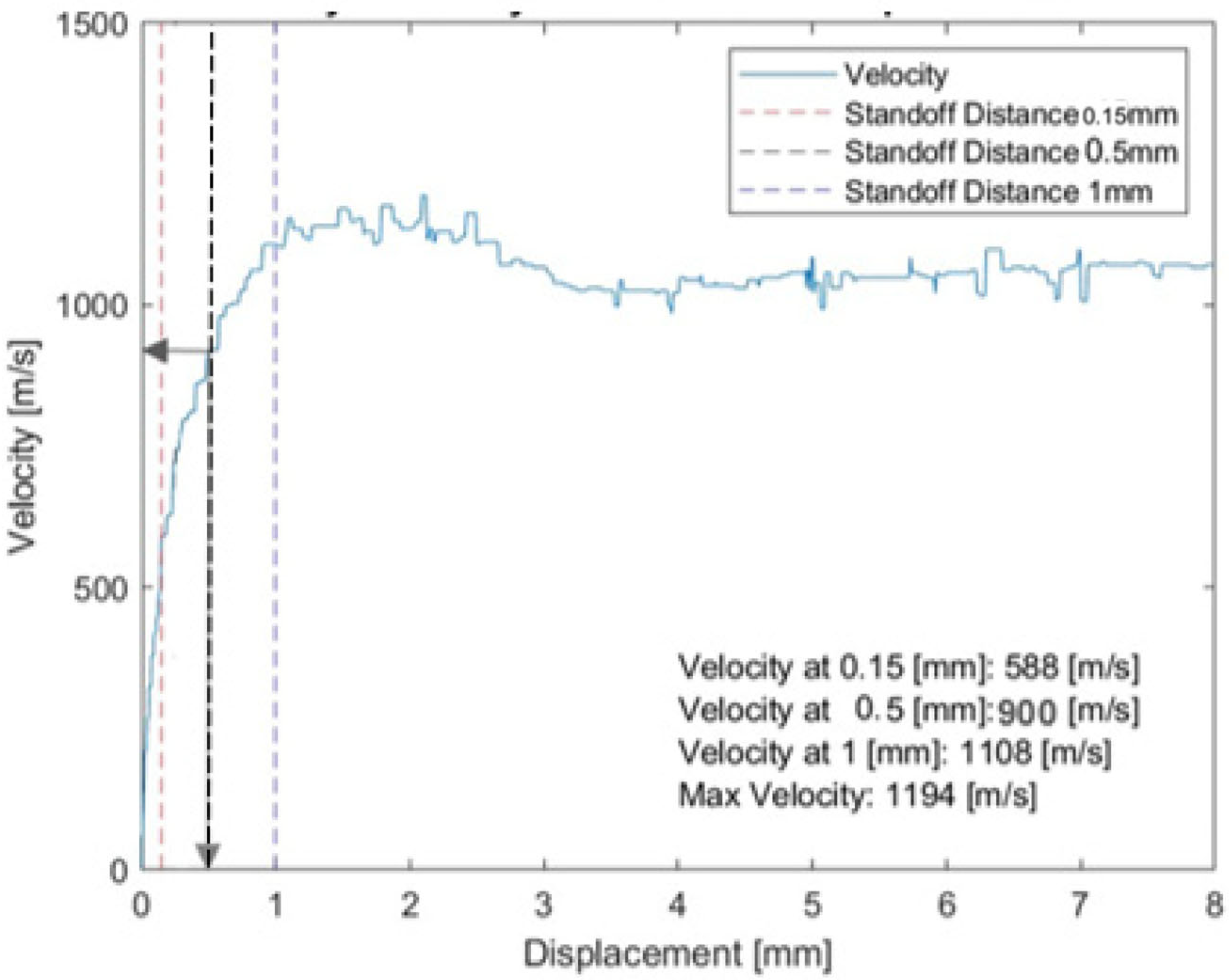





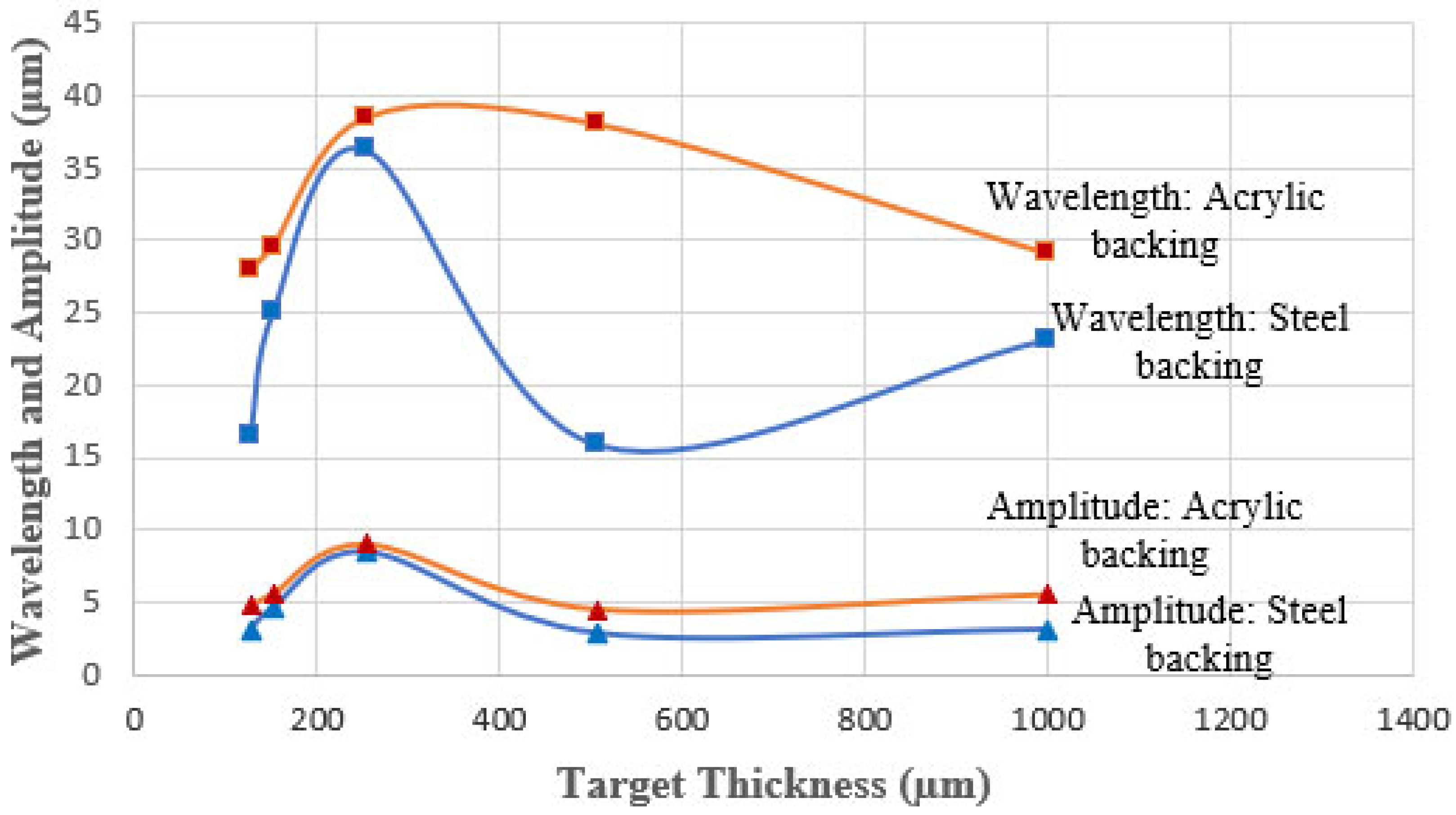

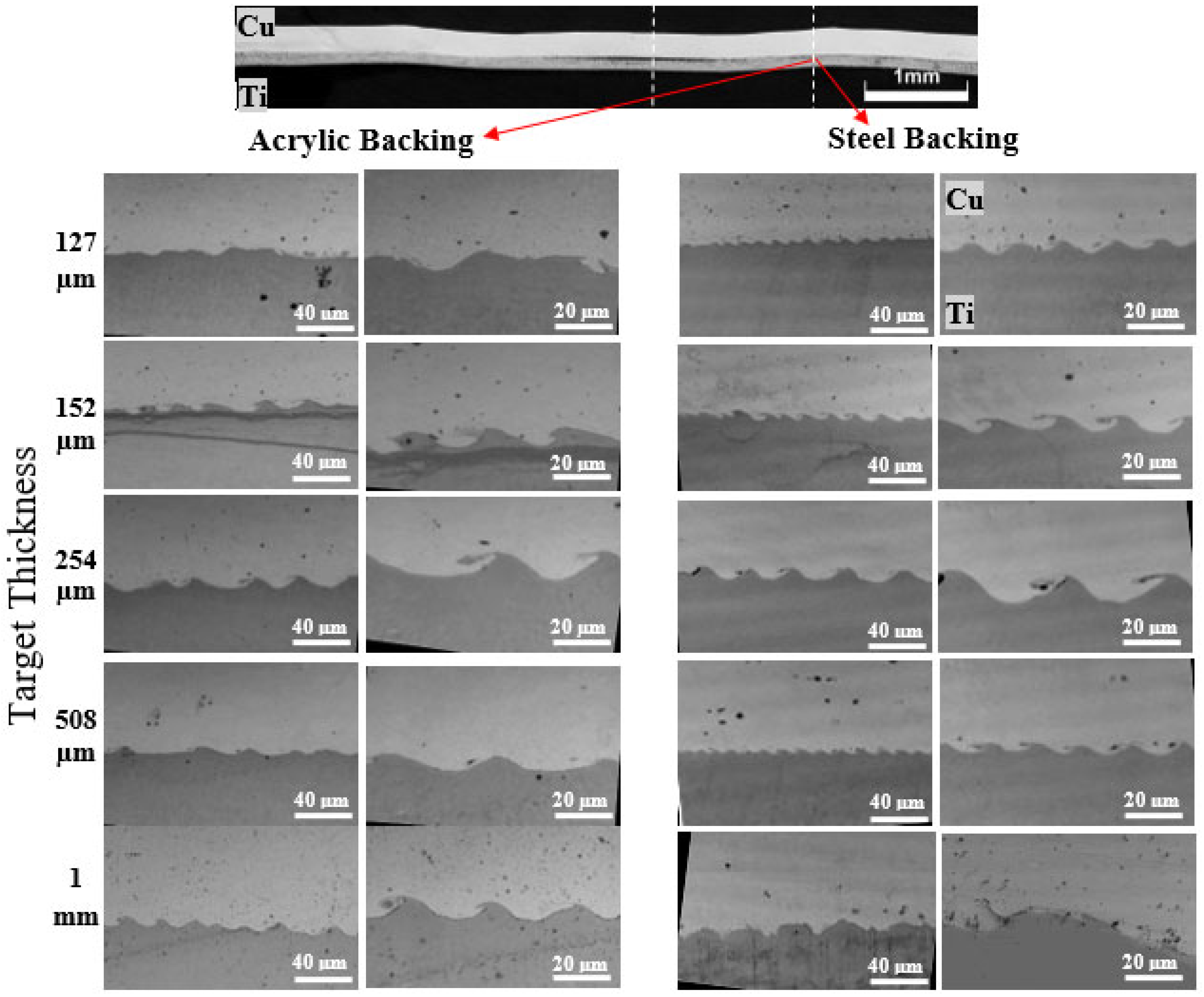
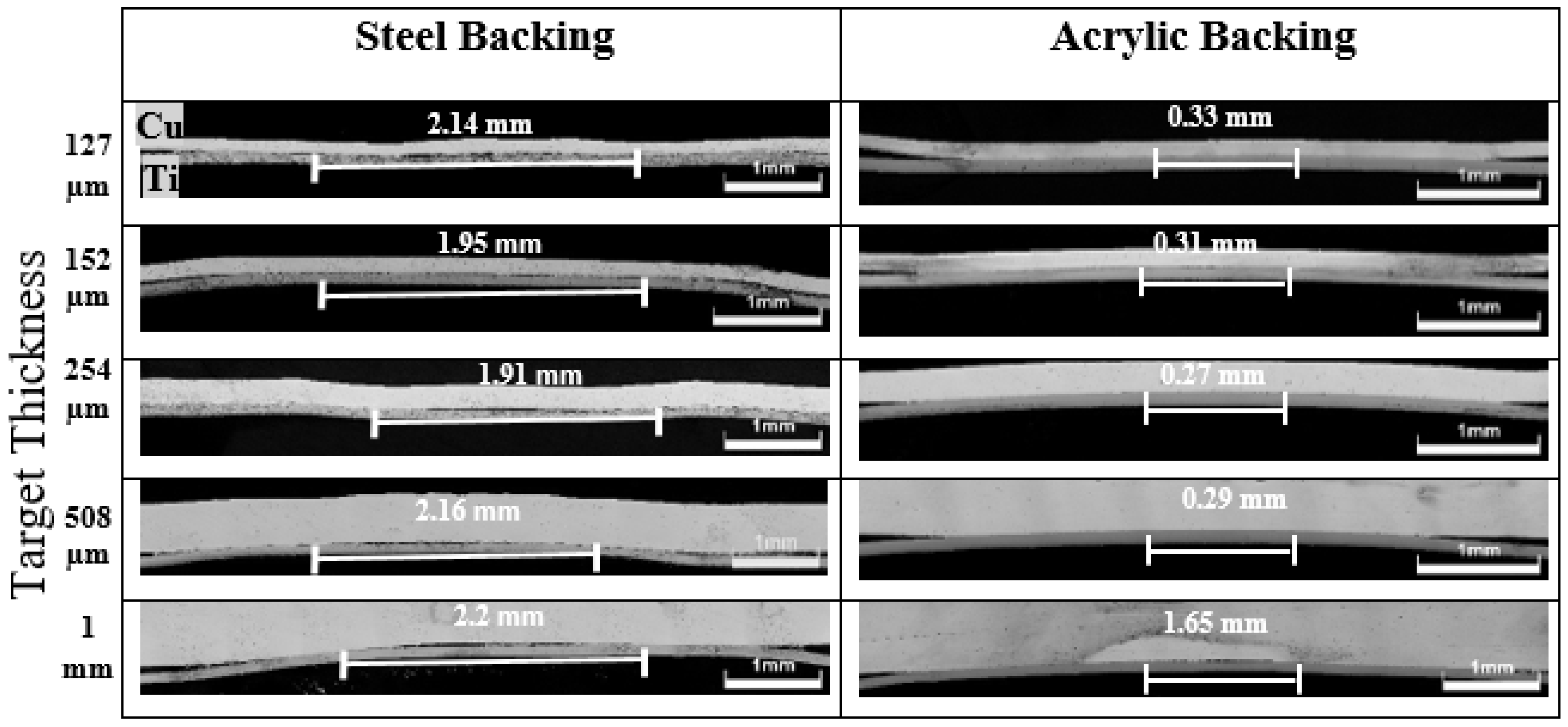
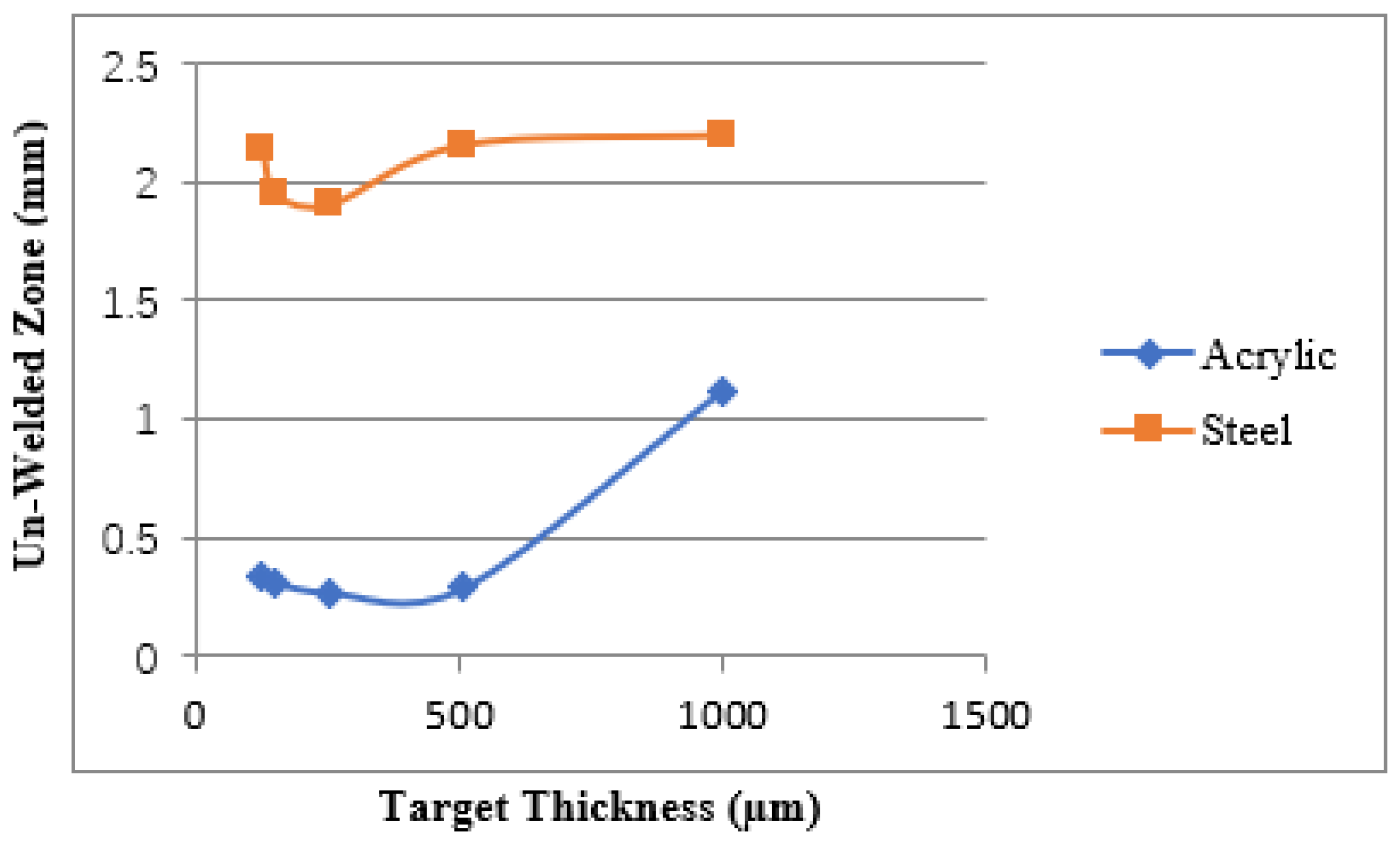
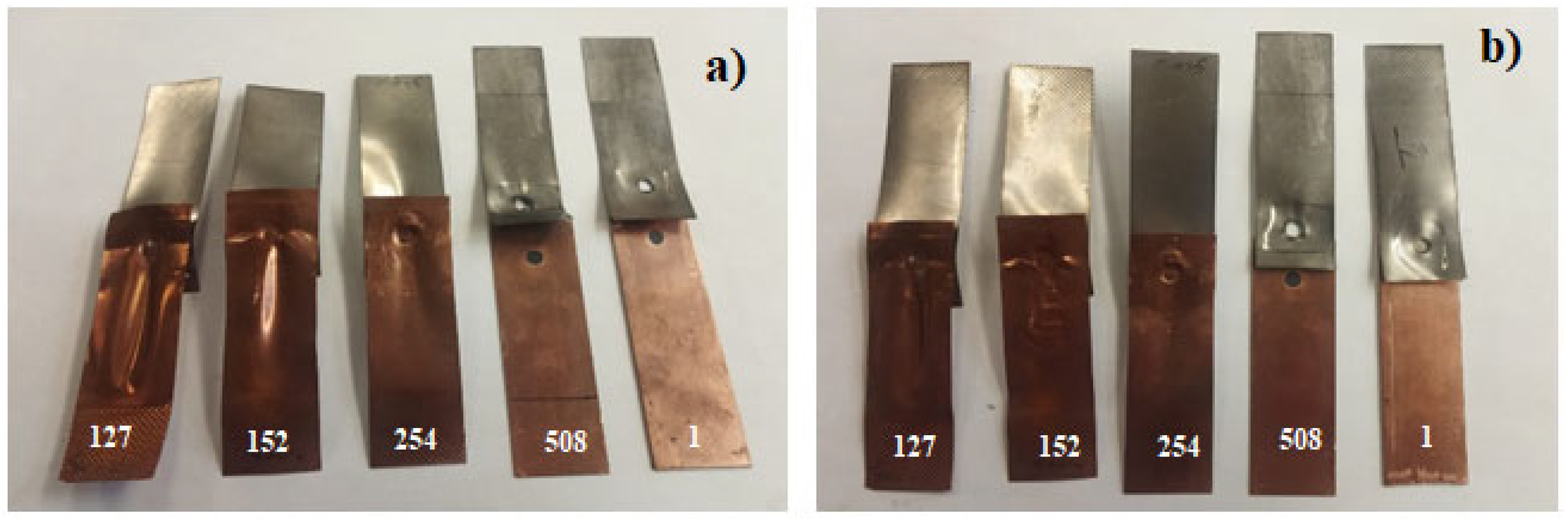
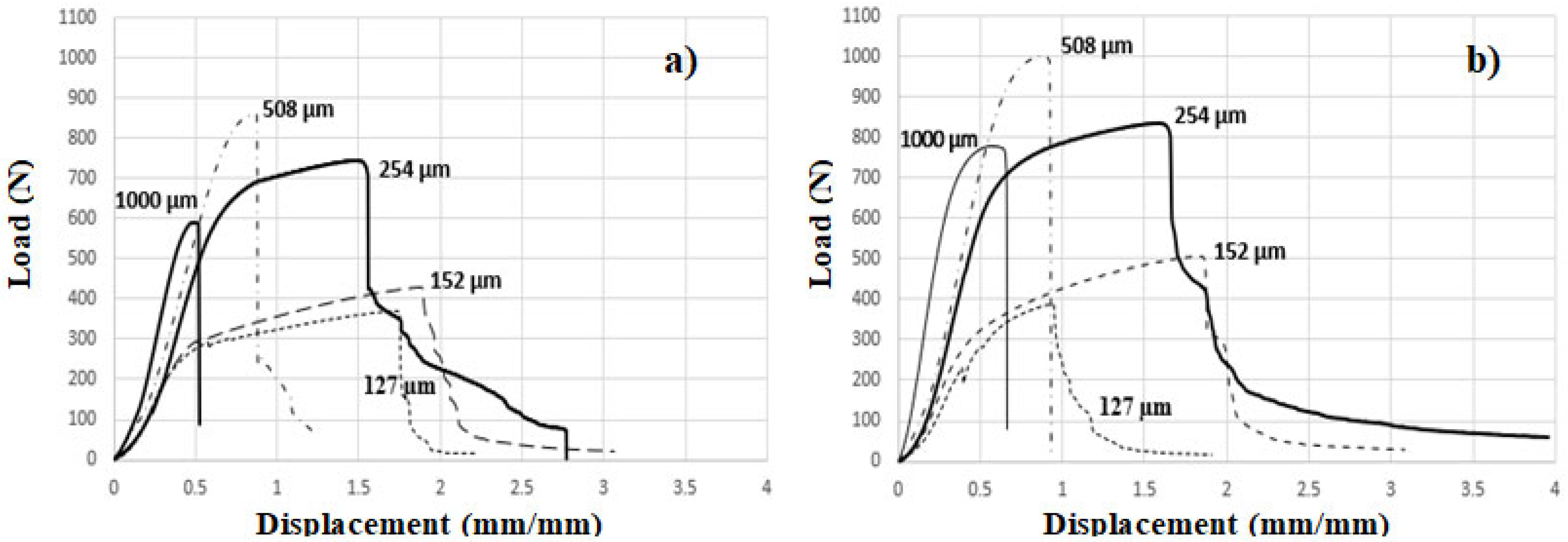
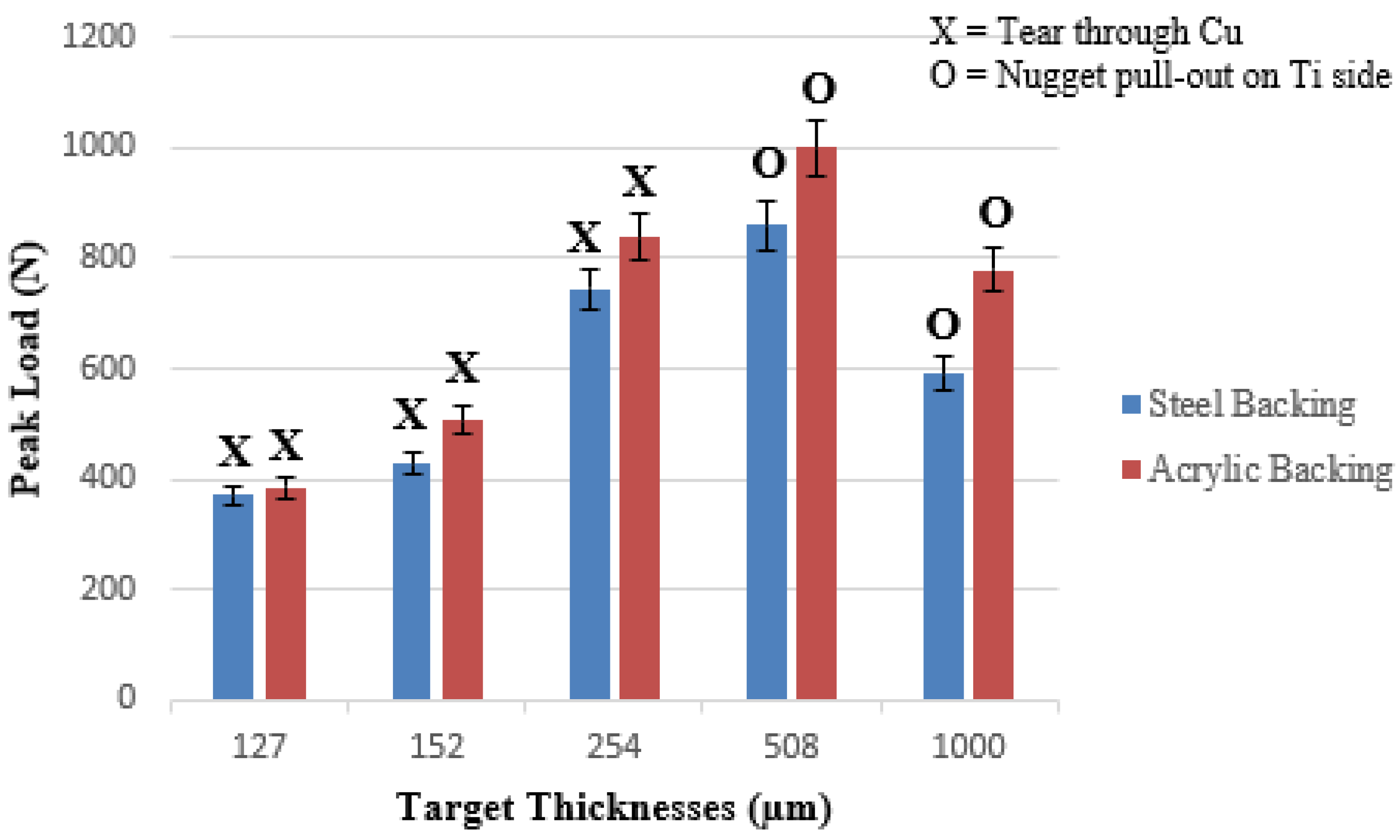

| Power Density (GW/cm2) | Energy (J) | Wavelength (nm) | Pulse Width (nm) | Spot Size (mm) |
|---|---|---|---|---|
| 1.34 | 3.14 | 1064 | 8 | 5.22 |
| Directionality | Perpendicular | Parallel | |||
|---|---|---|---|---|---|
| Target Thickness (µm) | Wavelength (µm) | Amplitude (µm) | Wavelength (µm) | Amplitude (µm) | |
| 127 | 16.46 | 3.11 | 9.35 | 1.46 | |
| 152 | 25 | 4.6 | 22.8 | 4.3 | |
| 254 | 36.23 | 8.42 | 35.4 | 7.76 | |
| 508 | 15.8 | 2.83 | 9.85 | 1.85 | |
| 1000 | 23.15 | 3.1 | 20.45 | 2.26 | |
| Target Thickness (µm) | Steel Backing | Acrylic Backing | ||
|---|---|---|---|---|
| Wavelength (µm) | Amplitude (µm) | Wavelength (µm) | Amplitude (µm) | |
| 127 | 16.46 | 3.11 | 28 | 4.7 |
| 152 | 25 | 4.6 | 29.6 | 5.53 |
| 254 | 36.23 | 8.42 | 38.5 | 9.06 |
| 508 | 15.8 | 2.83 | 38 | 4.43 |
| 1000 | 23.15 | 3.1 | 29.04 | 5.5 |
| Target Thickness (mm) | Steel Backing (mm) | Acrylic Backing (mm) |
|---|---|---|
| 0.127 | 2.14 | 0.33 |
| 0.152 | 1.95 | 0.31 |
| 0.254 | 1.91 | 0.27 |
| 0.508 | 2.16 | 0.29 |
| 1 | 2.2 | 1.65 |
Disclaimer/Publisher’s Note: The statements, opinions and data contained in all publications are solely those of the individual author(s) and contributor(s) and not of MDPI and/or the editor(s). MDPI and/or the editor(s) disclaim responsibility for any injury to people or property resulting from any ideas, methods, instructions or products referred to in the content. |
© 2024 by the authors. Licensee MDPI, Basel, Switzerland. This article is an open access article distributed under the terms and conditions of the Creative Commons Attribution (CC BY) license (https://creativecommons.org/licenses/by/4.0/).
Share and Cite
Abdelmaola, M.; Thurston, B.; Panton, B.; Vivek, A.; Daehn, G. The Effects of Target Thicknesses and Backing Materials on a Ti-Cu Collision Weld Interface Using Laser Impact Welding. Metals 2024, 14, 342. https://doi.org/10.3390/met14030342
Abdelmaola M, Thurston B, Panton B, Vivek A, Daehn G. The Effects of Target Thicknesses and Backing Materials on a Ti-Cu Collision Weld Interface Using Laser Impact Welding. Metals. 2024; 14(3):342. https://doi.org/10.3390/met14030342
Chicago/Turabian StyleAbdelmaola, Mohammed, Brian Thurston, Boyd Panton, Anupam Vivek, and Glenn Daehn. 2024. "The Effects of Target Thicknesses and Backing Materials on a Ti-Cu Collision Weld Interface Using Laser Impact Welding" Metals 14, no. 3: 342. https://doi.org/10.3390/met14030342







